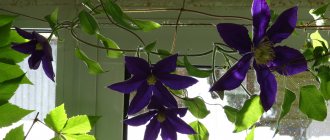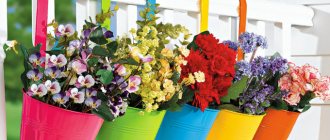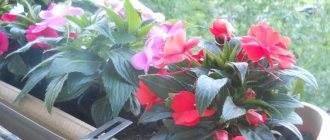With the onset of the cold season, balconies are usually empty: flowering annuals have faded, indoor plants have been moved into the apartment. However, you can arrange a winter garden on it and admire the beautiful plants even after the onset of cold weather.
Of course, it won’t be possible to leave plants on an open balcony until spring. The snow is blowing here and the temperatures are very cold. If the balcony is glazed, and even more so insulated, then the dream of a winter oasis is real (with the exception of the northern regions). The temperature here is above zero, even if it’s -10°C outside. Only in extreme cold, when it’s -30°C outside, it can be -5°C here.
How to preserve perennials on the balcony in winter
Many plants cannot survive in frost and therefore, to decorate balconies, you need to select ones that do not require care.
Most of them overwinter well in containers. Some do not shed their leaves for the winter, for example, euonymus and are most valuable for decorating loggias in winter. The most valuable are coniferous and evergreen plant species. Some shrubs lose their leaves, but can be attractive with interesting twig shapes, such as barberry.
It is better to choose small shrubs for comfortable maintenance.
A very beautiful evergreen, dwarf Mahonia 'Apollo' is smaller and more compact than regular Oregon grapes and has large flowers with a pleasant aroma. The flowering period is from April to May. Later, blue edible fruits appear from which you can make jam or add to homemade wine.
This evergreen plant features reddish-brown foliage in fall and winter. Young leaves also have a bronze color.
Interesting fact: Mahonia holly is the closest relative of barberry from the same barberry family. It has several names - Oregon mountain grape, California barberry, holly barberry, grape holly.
Magonia Apollo is unpretentious and can grow both in sunny places and in the shade. In the sun it forms attractive dense bushes, but overwinters better in a semi-shaded place. Mahonias are not affected by pests; the only dangerous diseases can be fungal infections, which can be easily cured with modern fungicides.
Mahonia Apollo is undemanding to the soil, prefers fresh, humus-rich soils, but grows in both wet and dry, from acidic to slightly alkaline, dry places. Prefers partial shade and does not require annual shaping haircuts.
The greatest advantage of buying potted plants is that they can be grown without purchasing additional fertilizers, from March to December - even during the hottest days of summer.
It is better to insulate the root system for the winter, and the bright leaves will delight you all winter.
climbing plants
In winter, stems of perennial vines such as ivy, clematis or wild grapes can decorate the balcony.
Ground cover
If you want to fill empty spaces in containers after the above-ground parts of some plants die, then sedum or sedum are best suited for this purpose. Some varieties of this plant can withstand frost even in small containers.
In winter, they tend to have leaves that turn red from frost. Inflorescences that form during winter can bloom in March-April. The flowers vary depending on the plant variety, but are mostly small and fluffy.
It is very good to grow sedum in compositions with other succulents or coniferous plants that do not require frequent watering.
With the onset of cold weather, the balcony loses its bright colors and becomes gray and boring. Indoor plants freeze, summer flowers fade, and only dull empty pots are stored here until spring. Is it possible to add greenery to the balcony in winter?
In late autumn, the balcony and loggia become not the most attractive places in the house. It’s cold and uncomfortable here, people spend less and less time in this corner. But this is not a reason to forget about him for several months. An unusually decorated balcony attracts attention from the outside, but its beauty can be admired from the inside. What if you turn a balcony or loggia into a cold winter garden?
The temperature on the balcony is 5 and above (although a short-term drop to 0 is possible). Many plants can be used for winter landscaping on a balcony. Chlorophytum and zonal pelargonium will grow from ordinary indoor ones. From the many beautiful hybrids of pelargonium, you should choose the simplest one, which grandmothers call geranium. Yucca filamentosa and Washingtonia palm can withstand such low temperatures on the balcony well - these plants tolerate light frosts.
The camellia can become the queen of the winter garden on the balcony; most camellias can withstand temperatures down to minus 5 degrees below zero. At temperatures from 0 to 15, the balcony is the best place for it. Many gardeners keep azaleas on the balcony with some caution (the minimum temperature for it is 5-6°C). Cyclamen also love the cold during flowering; the ideal temperature for them is: 10-15°C during the day and 6-8°C at night, which usually happens on glazed balconies with insulation.
In the fall, many flower shops offer heathers or ericas.
These are low, cold-resistant shrubs strewn with small bell flowers. They bloom in autumn and winter and look very decorative for a long time, even when they have already dried out. A special feature of this plant is the ability to retain flowers painted in the original color on the branches.
Hebe, or hebe (Hebe) is a plant still little known in Russia, but it is a large genus of evergreen low shrubs; there are many varieties of hebe that can withstand short-term drops in temperature to -5-6 degrees below zero. Hebe thickleaf is successfully grown even in summer cottages in central Russia; in a cold winter garden on a balcony this plant will grow without problems.
Ivy is used for vertical gardening; many of its varieties are frost-resistant; they successfully winter in the soil in the Crimea, in the Odessa region, where the temperature drops to minus 10 degrees.
In February, the winter garden on the balcony can be enlivened with blooming hyacinths and primroses. Hyacinths are taken out into the cool when they have already expelled the peduncle and begin to bloom; flowering in the cool lasts much longer than in a warm apartment.
During the day, on a sunny balcony the temperature rises to 10-15 degrees and the plants will be quite comfortable here. It will also be good for the owners of the winter butt among the green plants on the balcony when there is still snow behind the glass.
The temperature on the balcony is from 5 to -5 (shortly down to -10). On such a cold balcony in winter, you can use evergreen garden plants. In the fall, buying such a plant in a tub or pot is not at all difficult. They are sold for planting in gardens. These include dwarf spruce and pine, juniper, fir, thuja, and boxwood (buxus). After wintering on the balcony, it is best to plant these plants in the garden in the spring; most likely, it will not be possible to keep them in the house in the summer.
A very beautiful plant for winter landscaping of a balcony or loggia is the euonymus. Fortune's euonymus "Coloratus" (Euonymus fortunei "Coloratus") or Fortune's euonymus "Emerald en Gould" with variegated leaves can tolerate frosts down to minus 35 degrees. Frost turns their leaves pink-purple.
Wintergreen (Gaultheria procumbens) is a still unfamiliar evergreen subshrub up to 15 cm high, the bright red inedible berries of which sometimes remain on the bush all winter and these bright spots look very tempting in the white New Year's landscape.
It is very rare to find Pyracantha on sale. This is a perennial evergreen frost-resistant shrub, the bright red fruits of which persist throughout the winter and look especially impressive against the background of dark green foliage. Perfect for a winter garden on a cold balcony.
A balcony is a room with a limited usable area, but even its small space can be used profitably with the right selection of materials. Here you should not use plants in boxes of different shapes and volumes. It makes more sense to install internal or external shelves on which flowers in pots or small tubs are displayed. Plants should be selected according to the principle of complementation: their shades and structure should not conflict with each other - all aesthetics are lost.
Flowers on the balcony in boxes
An excellent option for a small balcony is the vertical gardening method. A variety of design solutions allows you to create blooming balconies that will delight owners all year round. You can use hanging plants for the balcony, ivy or flower pots with vines. Petunias or ampelous geraniums are suitable for this purpose.
We invite you to familiarize yourself with an impressive harvest and excellent aroma - the Amulet F1 tomato: description of the variety and planting tips
If you install special supports or decorative trellises, you can let climbing plants climb along them, which will twine around the rods and create a green fence or flower screen. Annuals will cope with this task: kobei, climbing nasturtiums.
Flower screen from balcony lattice
Landscaping balconies and loggias are similar processes that have their own nuances. The useful area on the loggia is much larger, which allows you to implement more interesting ideas. To decorate the space, you can use containers that harmonize with each other and are easy to rearrange. This allows you to change the viewing panorama, create shaded areas or protection from the wind.
Flower box for the balcony
It is important to remember that not all indoor plants can be used to decorate a balcony or loggia. A greenhouse on the balcony is a suitable place only for unpretentious plants. These can be: fuchsia, pelargonium, aloe, violets, lilies, balsams, etc.
Selection of plants according to the location of the balcony:
- If the balcony is glazed and located on the east or west side, most indoor plants that tolerate changes in habitat and minor temperature changes can be used for decoration.
- The north side is not suitable for sun-loving plants. Cacti or succulents are usually grown on a south-facing balcony, but it is still recommended to create artificial shading.
Flowers on the loggia photo
Camellia can withstand up to -5 degrees of frost, azalea requires at least five degrees of heat and about the same for cylkamen.
However, they require moving during the summer; the heat is destructive for them.
Also, in warm loggias you can plant almost any flowers, including indoor flowerpots. Here the factor of the location of the balcony continues to play a role.
LiveInternetLiveInternet
-Video
—Categories
- Sew with your own hands (777)
- Workshop (745)
- Jewelry (49)
- Mosaic (12)
- Frames (3)
- Health and beauty (576)
- Fine arts (509)
- Materials for artists (400)
- Drawing lessons (389)
- Delicious and healthy recipes (322)
- Self-development (317)
- Interior and exterior design (290)
- Spiritual practice (240)
- Different types of painting (210)
- Utilities (191)
- Art teacher (190)
- Origami! (179)
- Laws of life (154)
- Music (136)
- Interesting knitting (116)
- Self-organization (110)
- Books (106)
- Mini garden (100)
- Travel around the world (95)
- Batik (85)
- This is interesting (84)
- Chinese painting (79)
- Art photo (70)
- Esoterics (69)
- Cinema (59)
- Floriology (57)
- Enlightenment (56)
- Smile (49)
- Ornaments (49)
- Arts and crafts (46)
- Slavic traditions (46)
- Poetry (42)
- Prayer (31)
- GOD (18)
- Architecture (15)
- CREATIVITY (14)
- Angels (12)
- Volgograd (12)
- DIY cards (9)
- Nonsense










